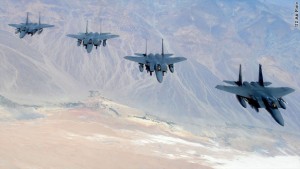 The Stockholm International Peace Research Institute (SIPRI) has released its annual assessment of the global arms trade, and the United States once again has the dubious distinction on coming in at the number-one spot. For the period covering 2010 to 2014, the U.S. accounted for 31 percent of global arms sales, followed by Russia at 27 percent. The next largest exporters — China, (5%), France (5%), Germany (5%) and the United Kingdom (4%) — lagged far behind.
The Stockholm International Peace Research Institute (SIPRI) has released its annual assessment of the global arms trade, and the United States once again has the dubious distinction on coming in at the number-one spot. For the period covering 2010 to 2014, the U.S. accounted for 31 percent of global arms sales, followed by Russia at 27 percent. The next largest exporters — China, (5%), France (5%), Germany (5%) and the United Kingdom (4%) — lagged far behind.
But the SIPRI figures tell only part of the story. They cover deliveries of major weapons systems, but they do not account for tens of billions in deals that have already been agreed upon but have yet to result in deliveries. For example, in its first five years in office, the Obama administration entered into new agreements worth over $160 billion through the largest U.S. channel of U.S. arms exports, the Pentagon’s Foreign Military Sales (FMS) program. This far outpaces past U.S. administrations, and is more than $30 billion more than the Bush administration entered into in its full eight years in office. Taking a longer view, the Obama administration has made more FMS deals than any U.S. administration since World War II, slightly outpacing the amount approved during the Nixon years.
Aside from supplying a lucrative new market for U.S. arms manufacturers like Boeing and Lockheed Martin, what impact have these sales had?
Perhaps the clearest example comes in the Middle East, where Saudi Arabia is using U.S. supplied aircraft, missiles and bombs to attack neighboring Yemen, with the risk of sparking a regional war in the process. And as a new analysis by Seth Binder of the Security Assistance Monitor has noted, the nine other countries supporting the Saudi intervention in Yemen have received over $10.5 billion in security assistance and $21 billion in arms sales deliveries from the United States from FY 2009 to FY 2014, with billions more to come. The Saudis have also used U.S.-supplied arms to help put down the democracy movement in Bahrain.
The weapons being used by the Saudis aren’t the only U.S. arms involved in the Yemen conflict. The U.S. military has lost track of $500 million in small arms and light weapons in Yemen. These weapons are believed to have fallen into the hands of either the Houthis or Al Qaeda in the Arabian Peninsula (AQAP). Last but not least, former Yemeni security forces fighting on both sides of the current conflict have long benefited from U.S. arms and training. So it is quite possible that every side in the complex war in Yemen has received arms from the United States. It’s hard to think of a clearer indictment of runaway arms dealing.
But it’s not necessary to go all the way to the Middle East to find evidence of the negative consequences of U.S. arms dealing. Much closer to home, the United States has dramatically increased arms transfers to Mexico in support of the Mexican government’s ill-fated and counterproductive war on the drug cartels. The Pentagon has approved over $1 billion in arms sales to Mexico in the past year alone, including over 20 Black Hawk helicopters and 3,335 multi-purpose wheeled vehicles that can be used either for fighting the cartels or for internal repression.
Despite pledges by the government of Enrique Pena Nieto to bring the military and police under control, human rights abuses by security personnel involved in the drug wars have continued. According to Human Rights Watch, over 26,000 people have been reported disappeared or missing in Mexico since 2007. As it also notes, “the government has made little progress in prosecuting widespread killings, enforced disappearances, and torture committed by soldiers and police in the course of efforts to combat organized crime, including during Pena Nieto’s tenure.“
Meanwhile, the centerpiece of Mexico’s militarized approach, known as the “Kingpin Strategy,” has been a dismal failure. This week’s announcement that Mexican security forces have captured Jesus Salas Aguayo, a leader of the Juarez Cartel, does not change this fact. Mexico’s Excelsior newspaper has noted that high-profile arrests of this kind “look like a smokescreen to distract society from other problems.” And they have actually made the problem of drug trafficking and violence on the part of the drug cartels worse.
As an analysis by Gabrielle Acierno and Sarah Kinosian of the Security Assistance Monitor has indicated, the attacks on the big cartels have simply resulted in their fracturing into dozens of smaller, even more vicious organizations. For example, last year the murder rate doubled in the state of Guerrero, which has been a focused of the militarized anti-drug strategy.
Saudi Arabia and Mexico are just two of many examples of how pouring U.S. weaponry into the midst of complex conflicts simply makes matters worse – in some cases much worse. It’s time for the Congress and the Obama Administration to recognize this reality and reverse course, reining in the U.S.-backed arms trade before it does further damage.
William D. Hartung is director of the Arms and Security Project at the Center for International Policy and an Advisor to the Security Assistance Monitor. He is a columnist for the CIP Americas Program www.americas.org



